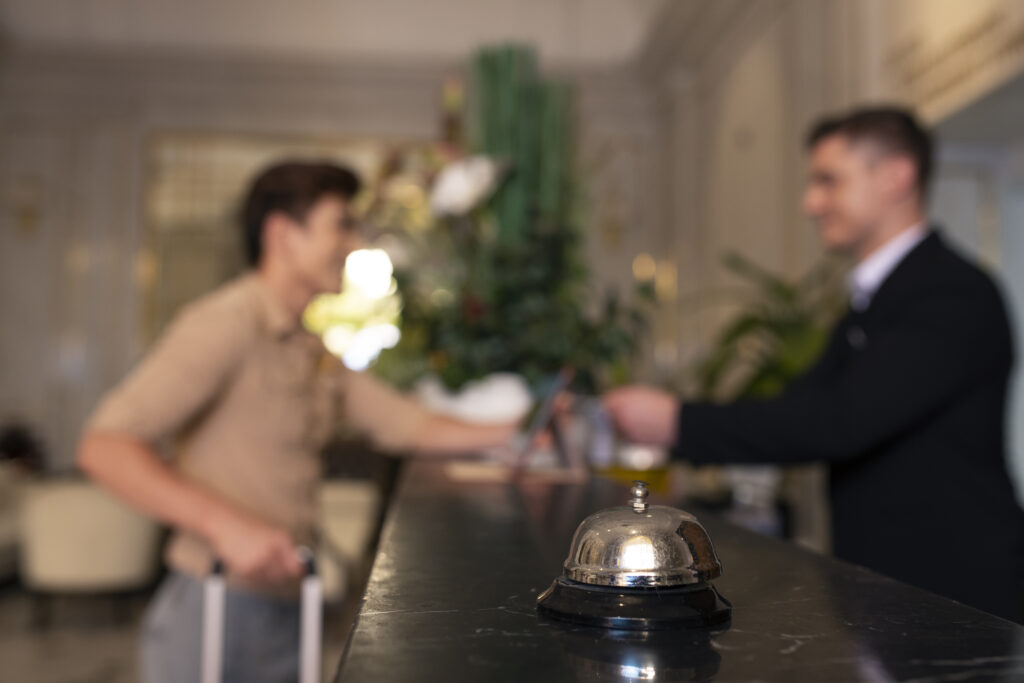How DL Interiors Helped a Dublin Hotel Achieve a 25% Increase in Bookings
Hotel renovation in Ireland is becoming essential in today’s competitive hospitality market. In South Dublin, a boutique hotel struggled with dated interiors despite great service and location. To improve reviews, increase bookings, and stay competitive, they needed more than surface fixes—they needed a strategic design-led renovation. Great service and prime locations aren’t enough when interiors feel dated or inconsistent. First impressions matter—especially in guest reviews and booking decisions.
One boutique hotel in South Dublin found itself struggling for relevance. Despite strong service and a desirable neighbourhood, outdated rooms and mismatched finishes drove down occupancy and negative reviews. To regain competitive edge, they needed change—and fast.
Enter DL Interiors. Over six weeks, our team executed a comprehensive renovation—guest rooms, stairwells, bathrooms, and custom blackout blinds—on a phased schedule that allowed the hotel to stay open. Within just three months of reopening, their booking rate surged 25%, and glowing five-star reviews praised the refreshed interiors.
This isn’t just flooring and fittings—it’s a performance upgrade. Discover how our bespoke interior solutions became the catalyst for occupancy growth and lasting guest loyalty.
1. The Challenge: Staying Competitive in a Crowded Market
1.1 Competitive Pressure from Modern Hotels
South Dublin’s boutique landscape is overflowing with newly refurbished hotels. While our client offered stellar service and location, their interiors looked tired—dated walls, mismatched bathroom tiles, and worn furnishings signaled neglect rather than charm. Guest reviews often mentioned “a tired look” or “could use an update”—comments that directly hurt occupancy and repeat bookings.
1.2 Disjointed Aesthetic Across Property
With renovations carried out at different times using various vendors, the hotel lacked cohesive branding. Room styles clashed. Bathrooms felt dated, yet stairwells looked brighter—a visual inconsistency that undermined professionalism and value perception.
1.3 Disruption & Budget Pressure
With high-season revenue on the line, the hotel needed a renovation that wouldn’t shut down operations—and a strong ROI to justify the spend.
2. DL Interiors’ Turnkey Renovation Solution
Our full-service renovation model was built for efficiency, consistency, and minimal disruption.
2.1 Discovery & Design
We began with a structured walk-through and design consultation, gathering insights on branding, guest profile, and material preferences. Visual mock‑ups included:
- Bespoke carpentry plans for headboards, desks, and storage
- Herringbone-pattern wooden flooring for guest rooms and landings
- Custom blackout blinds with enhanced thermal properties
- Bathroom finish selection aligned with hotel brand
2.2 Detailed Quotation & Phasing
Our proposal covered all trades, materials, installation, and snagging. Phasing was carefully planned to renovate two to three rooms per week, plus shared spaces—allowing the hotel to remain operational at full capacity.
2.3 Procurement & Logistics
We sourced bulk materials for cost-efficiency—hardwood flooring, designer fittings, blackout blinds—all shipped and staged. A single logistics point of contact ensured smooth arrival and installation planning.
2.4 Installation & Project Management
Each phase was overseen by a dedicated project manager, who coordinated trades, maintained noise schedules, and provided weekly progress updates via before/after photos.
2.5 Quality Assurance & Handover
We performed final snagging audits, compliance checks, and deep cleaning at each stage. Guests received milestone updates, and empty rooms were prioritized for renovation during off-peak check-in times.
3. The Renovation Results
3.1 Style & Brand Cohesion
A unified design refreshed the lobby, stairwells, guest rooms, and bathrooms. Herringbone flooring, refined handrails, coordinated colour palettes, and appliances updated the overall aesthetic. Consistent room layouts and fittings reinforced the hotel’s boutique brand.
3.2 Comfort & Practicality Improvements
- Custom blackout blinds enhanced guest sleep quality
- New flooring improved underfoot comfort and cleanliness
- Redesigned bathrooms featured modern tiling and durable fixtures
These upgrades elevated comfort, reduced wear, and reduced noise complaints.
3.3 Minimal Operational Disruption
Thanks to meticulous planning, the hotel stayed open with no need for room closures or relocation. Phased work delivered within six weeks—without compromising guest experiences or hotel occupancy.
4. What the Hotel Achieved
4.1 25% Increase in Bookings
Within three months post-renovation, the hotel reported a 25% uplift in booking volume. The refreshed interiors made the hotel standout and justified higher rates during peak seasons.
4.2 Surge in Five-Star Reviews
Guest comments frequently praised the interiors (e.g., “stylish new rooms,” “silky blackout blinds,” “cohesive design throughout”). This helped drive search ranking algorithms and boosted direct traffic across OTA platforms.
4.3 Enhanced Guest Retention
Booking data showed more return guests—a clear sign renovations positively affected loyalty and opinions about value and quality.
4.4 Energy & Maintenance Savings
Feedback from staff highlighted easier cleaning and fewer maintenance issues, thanks to high-quality materials and components. Upgraded blackout blinds also improved insulation, reducing heat and noise transmission in rooms.
4.5 High ROI
Based on renovation budgets and increased nightly revenue, the hotel achieved an estimated <18-month ROI, aligning with industry best-practice benchmarks for targeted upgrades.
5. Why This Approach Works
5.1 Turnkey with Phased Execution
Our complete approach—from design through final touches—enabled coherent, consistent upgrades executed in phases without blocking off rooms or disrupting guests.
5.2 Aesthetic Meets Functionality
Renovations focused on both style and usability—luxurious herringbone flooring and blackout blinds with practical benefits—helping guests feel comfortable and valued.
5.3 Project Transparency
Weekly updates with before/after visuals and milestones built trust with hotel management and minimized operational anxiety.
5.4 Cost-Performance Alignment
Bulk sourcing enabled high-end materials without inflated procurement costs. A fixed-price model eliminated guesswork and prevented cost overruns.
6. A Successful Template for Hotel Renovations
This case study highlights a replicable formula for boutique hotels:
- Audit visual consistency and functionality across guest zones
- Design upgrades that align with brand and target market
- Plan phased execution to stay operational
- Use turnkey management to reduce management overhead
- Measure outcomes based on bookings, reviews, and guest retention
7. How to Transform Your Hotel
Step 1: Schedule a discovery call and walkthrough to uncover your property’s potential
Step 2: Review design options—mock-ups, material boards, and pricing
Step 3: Choose your phased plan and schedule
Step 4: Watch the transformation unfold—room by room
Step 5: Launch updated property with marketing strategy and enhanced online profiles
👉 Looking for expert hotel renovation in Ireland? DL Interiors delivers turnkey solutions.
8. In Summary
- Updated interiors enhance online visibility, guest perceptions, and direct bookings
- Phased renovations allow hotels to operate seamlessly during upgrades
- Quality materials reduce maintenance, improve comfort, and boost sustainability
- ROI comes not just from aesthetics—enhanced performance is the true payoff
DL Interiors helped this South Dublin boutique hotel transform its customer experience—and bottom line. By merging design excellence with smart execution, they turned interiors into an asset with measurable returns.
👉 Ready to elevate your hotel’s performance? Start your upgrade here!

